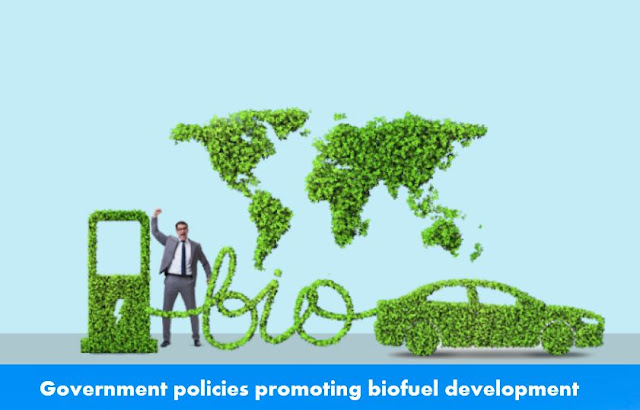Biofuel
Biofuel development
Biofuel development has come a long way in recent years, with advancements in technology, research, and investment leading to increased efficiency, lower costs, and greater sustainability.
Here are some of the key developments in biofuel development:
Second-generation biofuels: Second-generation biofuels are made from non-food sources such as waste materials, agricultural residues, and non-food crops. These biofuels have the advantage of not competing with food production and can be produced from waste streams or land that is not suitable for food crops. Technologies such as cellulosic ethanol, biobutanol, and renewable diesel are all examples of second-generation biofuels.
Algae-based biofuels: Algae-based biofuels are a type of third-generation biofuel that is made from microalgae. Algae grow quickly, require little land and water, and can produce high amounts of lipids, which can be converted into biodiesel. Researchers are working to improve the efficiency and scalability of algae-based biofuel production to make it more cost-effective.
Biofuel blends: Many countries have implemented policies that require a certain percentage of biofuels to be blended with petroleum-based fuels. Biofuel blends, such as ethanol blended with gasoline and biodiesel blended with diesel, can reduce greenhouse gas emissions and improve fuel efficiency.
Sustainable production: One of the key challenges with biofuel production is ensuring that it is sustainable and does not have negative environmental impacts. To address this challenge, many companies and governments are investing in sustainable production practices, such as using waste products as feedstock, reducing water usage, and minimizing land use.
Public-private partnerships: Biofuel development often requires significant investment in research and development, as well as infrastructure and production facilities. Public-private partnerships have emerged as a way to share risk and resources and to accelerate the development of biofuels. Governments, research institutions, and private companies are working together to advance biofuel development and bring sustainable biofuels to market.
Biofuel development has made significant progress in recent years, and the future looks bright for the continued advancement of sustainable biofuels. Ongoing research, investment, and collaboration are needed to further improve the efficiency and sustainability of biofuel production and to bring these technologies to scale.
Government policies promoting biofuel development
Governments around the world have implemented policies to promote the development and use of biofuels as a way to reduce dependence on fossil fuels, decrease greenhouse gas emissions, and support the growth of the biofuels industry. Here are some examples of government policies promoting biofuel development:
Renewable Fuel Standard (RFS)
Renewable Fuel Standard (RFS) in the United States: The RFS requires a certain volume of renewable fuels, including biofuels, to be blended into the transportation fuel supply each year. The RFS has been instrumental in driving the growth of the biofuels industry in the United States.
The Renewable Fuel Standard (RFS) is a federal program in the United States that was established by the Energy Policy Act of 2005 and expanded by the Energy Independence and Security Act of 2007. The goal of the program is to reduce greenhouse gas emissions and increase the use of renewable fuels such as ethanol and biodiesel in the transportation sector.
Under the RFS, the Environmental Protection Agency (EPA) sets annual renewable fuel volume requirements for four categories of biofuels: cellulosic biofuel, biomass-based diesel, advanced biofuel, and total renewable fuel. These requirements increase each year, with the ultimate goal of reaching 36 billion gallons of renewable fuel by 2022.
To comply with the RFS, oil refiners and importers are required to purchase and blend a certain amount of renewable fuel into their gasoline and diesel fuel. If they do not meet their renewable fuel obligations, they must purchase Renewable Identification Numbers (RINs) from other companies that have exceeded their renewable fuel obligations.
The RFS has been controversial since its inception, with some arguing that it is an important tool to promote the use of renewable fuels and reduce greenhouse gas emissions, while others argue that it places an undue burden on the oil and gas industry and raises costs for consumers. The program has also faced legal challenges, with court cases focusing on issues such as the EPA’s methodology for setting annual renewable fuel volume requirements and the use of waivers for small refineries.
The RFS has played a significant role in promoting the use of renewable fuels in the United States, and its impact on the transportation sector and the environment will continue to be debated and studied in the years to come.
Renewable Energy Directive (RED)
Renewable Energy Directive (RED) in the European Union: The RED sets targets for the use of renewable energy in transportation, including biofuels. The directive aims to increase the share of renewable energy in the transportation sector and reduce greenhouse gas emissions.
The Renewable Energy Directive (RED) is a European Union (EU) directive that was established in 2009 and updated in 2018. The goal of the directive is to promote the use of renewable energy in the EU and reduce the dependence on fossil fuels, with a particular focus on the transportation sector.
Under the RED, each EU member state is required to ensure that a certain percentage of its total energy consumption comes from renewable sources. In addition, the directive sets specific targets for the use of renewable energy in the transportation sector, including a target of 14% renewable energy in transportation by 2030.
One of the key provisions of the RED is the promotion of biofuels. The directive sets sustainability criteria for biofuels and requires that they achieve at least a 50% greenhouse gas emissions reduction compared to fossil fuels. The directive also promotes the use of advanced biofuels, which are made from non-food sources such as waste products and algae.
In addition to biofuels, the RED also promotes the use of other forms of renewable energy in the transportation sector, such as electric vehicles and hydrogen fuel cells. The directive includes provisions for the development of infrastructure to support these technologies, such as charging stations and hydrogen refueling stations.
The RED has been controversial, particularly in relation to the use of biofuels. Critics argue that the use of biofuels can have negative environmental impacts, such as deforestation and competition with food production. Others argue that the directive has not been effective in reducing greenhouse gas emissions and promoting sustainable energy.
Despite these controversies, the RED remains an important policy tool for promoting renewable energy in the EU and reducing greenhouse gas emissions in the transportation sector. The directive is expected to continue to evolve in the coming years as the EU works to achieve its climate and energy goals.
Biofuels Obligation Scheme in the United Kingdom: The Biofuels Obligation Scheme requires fuel suppliers to ensure that a certain percentage of their fuel comes from renewable sources, including biofuels. The scheme aims to reduce greenhouse gas emissions and increase the use of renewable energy in transportation.
National Biofuels Policy in Brazil:
National Biofuels Policy in Brazil: Brazil has implemented a national biofuels policy that promotes the production and use of biofuels, particularly sugarcane ethanol. The policy has contributed to the growth of the biofuels industry in Brazil and has helped to reduce the country’s dependence on imported oil.
Brazil is one of the world’s largest producers and consumers of biofuels, with a significant portion of its transportation fuel coming from renewable sources. The country’s National Biofuels Policy, also known as the RenovaBio program, was established in 2017 to promote the use of biofuels and reduce greenhouse gas emissions from the transportation sector.
Under the RenovaBio program, biofuels are classified according to their level of greenhouse gas emissions reduction compared to fossil fuels. The program establishes targets for reducing emissions from transportation fuels, and fuel distributors are required to purchase a certain amount of biofuels in proportion to their market share.
The policy also includes incentives for investment in the biofuels sector, such as tax exemptions and subsidies for research and development. Additionally, the program promotes the use of advanced biofuels made from non-food crops, waste materials, and other sustainable sources.
Brazil has a long history of producing biofuels, particularly ethanol made from sugarcane, and the RenovaBio program is seen as a way to further expand the country’s biofuels industry and reduce its dependence on imported fossil fuels. The program is also intended to help Brazil meet its commitments under the Paris Agreement on climate change by reducing greenhouse gas emissions from the transportation sector.
Biofuels Act in India
Biofuels Act in India: The Biofuels Act in India provides a framework for the development and use of biofuels in the country. The act aims to increase the use of biofuels in transportation, reduce greenhouse gas emissions, and create opportunities for farmers and rural communities.
India’s Biofuels Act, officially known as the “National Policy on Biofuels 2018”, was launched in May 2018 with the aim of promoting the production and use of biofuels in the country. The policy aims to reduce India’s dependence on imported fossil fuels, promote sustainable development in the agricultural sector, and address environmental concerns such as air pollution and climate change.
Under the Biofuels Act, the government has set a target of achieving 20% blending of ethanol with petrol and 5% blending of biodiesel with diesel by 2030. The policy also provides for financial incentives, including tax exemptions and subsidies, for the production and use of biofuels. In addition, the government has created a National Biofuel Coordination Committee to oversee the implementation of the policy and provide support to the biofuels industry.
The Biofuels Act encourages the production of biofuels from non-food sources, such as agricultural waste and forest residues, to avoid competition with food crops. The policy also promotes the use of second-generation biofuels, which are made from non-food sources and have a lower environmental impact than first-generation biofuels.
The Biofuels Act is an important step towards promoting sustainable development in India and reducing the country’s dependence on imported fossil fuels. By promoting the production and use of biofuels, the policy has the potential to create new opportunities for farmers, reduce greenhouse gas emissions, and improve energy security in the country.
Government policies promoting biofuel development are important for creating a supportive regulatory environment for the biofuels industry. By setting targets, providing incentives, and creating a framework for the development and use of biofuels, governments can help to promote the growth of a sustainable and renewable source of energy.
Conclusion for Government policies promoting biofuel development
Governments around the world have been implementing policies to promote the development and use of biofuels as a way to reduce reliance on fossil fuels and lower greenhouse gas emissions.
Some examples of these policies include:
Renewable Fuel Standards (RFS) – These policies require a certain amount of biofuels to be blended with gasoline and diesel fuel. The United States and several other countries have implemented RFS programs to promote the use of biofuels.
Biofuel subsidies – Governments may offer financial incentives for the production of biofuels, such as tax credits or grants. These subsidies can help make biofuels more competitive with traditional fossil fuels.
Mandates and quotas – Some countries have established mandates or quotas that require a certain percentage of transportation fuel to come from renewable sources, including biofuels.
Research and development funding – Governments may provide funding for research and development of new biofuels technologies, including advanced biofuels that can be produced from non-food sources.
Import tariffs – Some governments impose tariffs on imported fossil fuels to encourage the use of domestically produced biofuels.
These policies can be effective in promoting the development and use of biofuels, but they can also have unintended consequences. For example, policies that promote the use of biofuels made from food crops can lead to higher food prices and deforestation if land is converted to grow biofuel crops. As a result, it is important for governments to carefully consider the potential impacts of biofuel policies and develop strategies to mitigate any negative effects.
https://www.exaputra.com/2023/04/government-policies-promoting-biofuel.html
Renewable Energy
Sins and Virtues
 It’s worth taking a look at the “Deadly Sins” and “Holy Virtues” at left, and asking:
It’s worth taking a look at the “Deadly Sins” and “Holy Virtues” at left, and asking:
Who are we as a nation?
How have we changed overtime?
Have we chosen a leader who will take us in the right direction?
Renewable Energy
Germany Hits Negative Prices As France Goes Subsidy-Free
Weather Guard Lightning Tech

Germany Hits Negative Prices As France Goes Subsidy-Free
This episode covers three major wind power milestones: Germany hitting 51 GW of wind output with negative electricity prices, France launching its first floating offshore wind farm without subsidies, and Australia’s Goyder South becoming South Australia’s largest wind farm at 412 MW.
Sign up now for Uptime Tech News, our weekly email update on all things wind technology. This episode is sponsored by Weather Guard Lightning Tech. Learn more about Weather Guard’s StrikeTape Wind Turbine LPS retrofit. Follow the show on Facebook, YouTube, Twitter, Linkedin and visit Weather Guard on the web. And subscribe to Rosemary Barnes’ YouTube channel here. Have a question we can answer on the show? Email us!
Welcome to Uptime News. Flash Industry News Lightning fast. Your host, Alan Hall, shares the renewable industry news you may have missed.
Allen Hall 2025: There is news today from three continents about wind power in Germany. Last Friday, the wind began to blow storm Benjamins swed across the northern regions. Wind turbines spun faster and faster. By mid-morning wind output hit 51 gigawatts. That’s right. 51 gigawatts the highest. Since early last year, wind and solar together met nearly all of Germany’s electricity needs, and then something happened that would have seemed impossible.
20 years ago, the price of electricity went negative. Minus seven euros and 15 cents per megawatt hour. Too much wind, too much power, not enough demand. Meanwhile, off the coast of Southern [00:01:00] France, dignitaries gathered for a celebration. The Provenance Grand Large floating offshore wind farm. 25 megawatts.
Three Siemens Gamesa turbines mounted on floating platforms. France’s first floating offshore wind project. a real milestone, but here is what caught everyone’s attention. No government subsidies. EDF, Enbridge and CPP investments. Finance the entire project themselves. Self-finance, offshore wind in France.
Halfway around the world in South Australia, Neoen inaugurated Goyder South. 412 megawatts, 75 turbines, the largest wind farm in the state, the largest in Neoen portfolio. It will generate 1.5 TERAWATT hours annually. That’s a 20% increase in South Australia’s total wind generation.[00:02:00]
The state is racing towards 100% net renewables by 2027. Goyder South created 400 construction jobs, 12 permanent positions, over 100 million Australian dollars in local economic impact. Three different stories, three different continents, Europe, Asia Pacific, all celebrating wind power. But there is something else connecting these projects.
Something the general public does not see something only industry professionals understand. 20 years ago, wind energy was expensive, subsidized, and uncertain . Critics called it a fantasy that would never compete with coal or natural gas. Today, Germany has so much wind power that prices go negative.
France builds offshore wind farms without government money. Australia bets its entire energy future on renewables, and here is the number that tells the real [00:03:00] story. In 2005, global wind power capacity was 59 gigawatts. Today it exceeds 1000 gigawatts the cost per megawatt hour. It has dropped about 85%.
Wind power went from the most expensive electricity source to one of the cheapest in about two decades faster than pretty much anyone had predicted, cheaper than anyone had really forecasted. the critics said it could not be done, and the skeptics said it would never compete. The doubters said it was decades away, and they were pretty much all wrong.
Today France celebrates its first commercial scale floating offshore wind farm. And Germany’s grid operator manages negative prices as routine Australia plans to run an entire state on renewable energy. Within about two years, the impossible became inevitable, and you, the wind energy professionals listening to this, you [00:04:00] made it happen.
Engineers, technicians, project managers, turbine designers, grid operators. Every one of you helped prove the skeptics wrong. 20 years ago, you were building a dream. Today you are powering the world.
https://weatherguardwind.com/germany-negative-price-france/
Renewable Energy
Ronald Reagan on America’s Greatness
 Ronald Reagan is a symbol of how far this country has fallen in terms of humanitarianism in just few decades.
Ronald Reagan is a symbol of how far this country has fallen in terms of humanitarianism in just few decades.
As a conservative, Reagan did many things, too many to list, that upset the bejeepers out of progressives like me. But at least he wasn’t a twisted, hateful, unAmerican madman like the Republicans of today.
Think for a minute how miserably unsuccessful you’d be running as a GOP candidate on the platform that Reagan articulated at left.
Now it’s, “Unless you’re a wealthy white guy, say, from Sweden, we don’t want you anywhere near the United States.”
-
Climate Change2 years ago
Spanish-language misinformation on renewable energy spreads online, report shows
-
Climate Change3 months ago
Guest post: Why China is still building new coal – and when it might stop
-
Climate Change Videos2 years ago
The toxic gas flares fuelling Nigeria’s climate change – BBC News
-

 Greenhouse Gases1 year ago
Greenhouse Gases1 year ago嘉宾来稿:满足中国增长的用电需求 光伏加储能“比新建煤电更实惠”
-
Greenhouse Gases3 months ago
Guest post: Why China is still building new coal – and when it might stop
-

 Climate Change1 year ago
Climate Change1 year ago嘉宾来稿:满足中国增长的用电需求 光伏加储能“比新建煤电更实惠”
-

 Carbon Footprint2 years ago
Carbon Footprint2 years agoUS SEC’s Climate Disclosure Rules Spur Renewed Interest in Carbon Credits
-
Renewable Energy4 months ago
US Grid Strain, Possible Allete Sale













